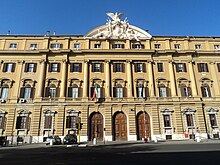Palazzo delle Finanze

The Palazzo delle Finanze ( German " Financial Palace " ) in Rome is the seat of the Italian Ministry of Finance . The palazzo is still one of the largest government buildings in the Italian capital today.
history
After Rome became the capital of Italy in 1871, the government decided to build a number of new government buildings on the Quirinal and Viminal and the plateau east of them. Several large ministries were to be located on Via del Quirinale and the subsequent Via XX Settembre between the Quirinal Palace and Porta Pia . The first new building on this traffic axis was the Palazzo delle Finanze , followed by the Ministry of War and the Ministry of Agriculture .
construction
The new building was suggested by the then finance minister, Quintino Sella . Under the direction of the engineer Raffaele Canevari, what was by far the largest government building in Rome at the time was built from 1872 to 1877. For this, the remains of the Porta Collina on the Servian Wall had to be removed. The palazzo with its three representative rectangular courtyards was built in the neo-renaissance style. The building, which is around 300 meters long and 120 meters wide, initially served not only as the seat of the Ministry of Finance, but also as the seat of the state depository , the audit office and the meeting place for the Council of Ministers .
Interior
The heart of the Palazzo delle Finanze is the Sala della Maggioranza . Allegorical figures represent the unification of Italy . Initially, this room also served as the meeting place for the Council of Ministers. Public meetings of the Court of Auditors used to take place in the Sala del Parlamentino , which is two floors high. It is worth mentioning the wooden conference benches on three sides of the hall and the wooden ceiling with floral motifs. In the minister's office there is still the original desk of the finance minister, Quintino Sella. This desk has been used by all of his successors to date.
Since 1961, the coin collection ( museo numismatico ) of the state mint IPZS has been in the Palazzo delle Finanze . The collection includes around 20,000 exhibits.
Remarks
- ↑ The designation Via XX Settembre refers to September 20, 1870. On this day, Italian troops invaded Rome at Porta Pia and via today's Via XX Settembre and occupied the former capital of the Papal States . Before that, the street was called Strada Pia . The area was sparsely populated at the time. Rome had around 200,000 inhabitants in 1870.
- ↑ Contrary to the original plans, it remained with these three new buildings. The Ministry of Foreign Affairs was housed in the Palazzo della Consulta until 1922 , which together with the Quirinal Palace stands at the beginning (or end) of this axis and was too small for this ministry. Opposite the Quirinal Palace, the Ministry of the Royal House was established in the former Jesuit convent of Sant'Andrea al Quirinale . The Ministry of Public Works was located immediately east of Porta Pia, and the Ministry of the Interior later on Viminal. The gardens around the church of Sant'Andrea al Quirinale were thus preserved.
- ↑ At that time there was no separate office for the Prime Minister, who therefore mostly had his office with other ministries, which also served as the meeting place for the Council of Ministers. In addition to the Ministry of Finance and the Ministry of Foreign Affairs, the Ministry of the Interior took on this task over the years. The audit office and the deposit fund were later outsourced. In the 20th century, the former Ministry of Finance was usually divided into a Ministry of Finance (tax revenue), a Ministry of the Treasury (asset management; see Federal Ministry of Treasury ) and a Ministry of the budget (expenditure). These ministries were all housed in the Palazzo delle Finanze , which is why it was also called the Palazzo dei Ministeri Finanziari or "Palais of the Finance Ministries ". Over time, the financial management ( Agenzia delle Entrate and others) was outsourced to more functional and modern buildings, so that today the Palazzo delle Finanze mainly serves as the representative headquarters of the ministry, where more basic political decisions are made.
- ↑ The museum was closed in 2011/12 for renovation work.
Web links
- Presentation on the website of the Italian Ministry of Finance (Italian)
- Website of the Numismatic Museum in the Palazzo delle Finanze (Italian)
Coordinates: 41 ° 54 ′ 23 " N , 12 ° 29 ′ 53.1" E

